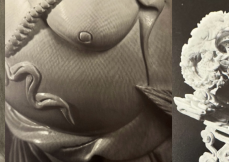
THE DEMANTOID GARNET | EN
"Stones of more than one carat are rare."
Last month, we were introduced to the mandarin garnet, and since the journey must continue we pay a visit this time to its cousin, the demantoid garnet.
This is one of the rarest and most sought after stones for its colour. The demantoid garnet takes its name from its adamantine lustre. The name is from the old German word demant meaning 'diamond', and it is certainly the case that this gem has a high refractive index and a dispersion greater than that of diamond. As a higher quality stone, the demantoid garnet is even greener and more saturated than the most beautiful green diamonds.
The perfect demantoid is a vivid green and is pure, and with a touch of secondary blue. This secondary blue is rarer than yellow, and the stones actually have a tendency to be clear green with a secondary yellow colour. Under the Chelsea filter, the demantoid acquires a rose hue. It has a hardness of 65 to 7 and a density of 382 to 385 Its composition contains iron and calcium silicate and its refraction index is 1.888 to 1889 It belongs to the andradite garnet family and the colour results from a combination of iron oxide and chromium.
This beautiful stone was discovered in the Urals in Russia around 1886. It has not been actively mined since the Bolshevik Revolution, though in fact the Tsarist court was obsessed by the stone and Faberge used the stone in its precious creations. In Russia, the green stones were worn only at Easter time as they embodied the colour of spring and of renewal. When he was a buyer for Tiffany, George Kunz was financed by JP Morgan to buy all of the demantoids he could find As a result of this, the stone quickly became the darling of the British and French aristocracy from the 19th Century onwards, and jewels from the Victorian era between 1885 and 1915 contained demantoid garnets. Aside from Russia, the gem can also be found in the Piedmont region of Italy as well as in Namibia, Iran, Congo, Mexico, Ethiopia and Brazi I.
The Klodovka demantoid mine in Russia is situated close to the village of Ekaterinbourg and in fact its discovery was a re-discovery of the original mine dating back to the 1800s the Russians resumed their research in May 2002 and were on the verge of abandoning their work just as the discovery was made in July. A few years earlier, in 1998, another site had been found in Russia, but the quality of its production was not as high. The mining operation of the demantoid is a very primitive procedure the manual work is done using chisels and hammers together with a couple of excavators, this being the basic equipment. Problematic climactic conditions in Russia also limit the mining season to three or four months a year at the most, and at present the mining area is 200 metres by a hundred and twenty metres deep The region, as described by Larson in an article by R. Genis, still resembles a mining operation in Burma or the Brazilian Jungle a dense forest overwhelmed by insects, enormous flies and aggressive mosquitoes.
One interesting feature of the Russian demantoid garnets is that almost all of them have radiating needles that often take on the appearance of a horsetail. Gemmologists are still searching for the origins of these inclusions, which remain a mystery. This characteristic inclusion is prized by precious stone collectors insofar as they identify the stone as being of Russian origin. This is one of the rare examples of an inclusion in a stone being a positive attribute, and the horsetail inclusion that is visible to the eye is actually a mark of high quality.
Garnets are assumed to be a precious stone that have not been artificially enhanced, though some are heated This low temperature procedure enables secondary brown co lou rs to be driven ou t. Stones of more than one carat are rare, and the present rate for the best quality one carat stone carries a public price of around seven thousand Euros. Prices continue to rise because of the small quantity of stones available on the market, and all of the available stones of this kind are from the one Russian mining operation that is presently suspended. Generally speaking the goods are round, cushion or oval and sometimes trillion cut. In order of importance, the demantoid markets are in Japan, Italy, France, Germany and the US. The stone is highly sought after by collectors and specialist jewellers and is proving to be an excellent choice for customers born in January looking for a green stone; the stone has a solar energy and stands for eternal youth.
Demantoid stones are sometimes confused with green zircon of a more blueish colour with a doubling of its facets. It can also be confused with sphene and titanium as well as with olivine and peridot. Right now is a good time to be buying this stone that is presently not treated and is considered rare by connoisseurs, rather like Kashmir sapphire or Russian alexandrite - the kind of stones whose mining life is short.
|










